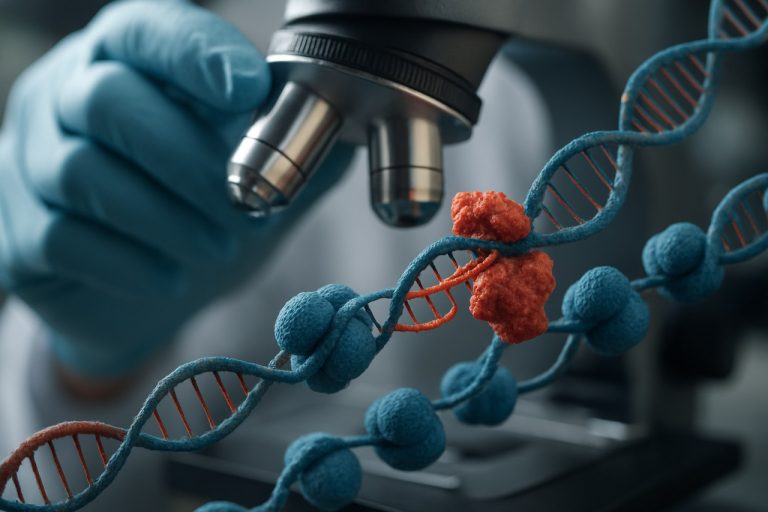
Unlocking the Power of CRISPR-Mediated Epigenome Remodeling: How Precision Tools Are Rewriting the Rules of Gene Expression and Disease Intervention
- Introduction to Epigenome Remodeling and CRISPR Technology
- Mechanisms of CRISPR-Mediated Epigenetic Modulation
- Key Applications in Disease Research and Therapeutics
- Advantages Over Traditional Gene Editing Approaches
- Challenges and Limitations in Epigenome Editing
- Recent Breakthroughs and Case Studies
- Ethical Considerations and Regulatory Landscape
- Future Directions and Emerging Technologies
- Sources & References
Introduction to Epigenome Remodeling and CRISPR Technology
Epigenome remodeling refers to the dynamic modification of chromatin architecture and DNA-associated proteins, which in turn regulates gene expression without altering the underlying DNA sequence. These modifications, including DNA methylation, histone modification, and chromatin remodeling, play crucial roles in development, cellular differentiation, and disease states. Traditional methods for studying and manipulating the epigenome have often lacked precision or scalability, limiting their utility in both basic research and therapeutic contexts.
The advent of CRISPR (Clustered Regularly Interspaced Short Palindromic Repeats) technology has revolutionized the field of genome engineering, offering a programmable and efficient means to target specific genomic loci. Beyond its well-known applications in gene editing, CRISPR has been adapted for epigenome remodeling by fusing catalytically inactive Cas9 (dCas9) with various effector domains. These engineered complexes can be directed to precise genomic regions to modulate epigenetic marks, such as DNA methylation or histone acetylation, thereby activating or repressing gene expression in a highly targeted manner.
CRISPR-mediated epigenome remodeling enables researchers to dissect the functional consequences of specific epigenetic modifications and holds promise for correcting aberrant epigenetic states associated with diseases. This approach offers unprecedented specificity, reversibility, and scalability compared to earlier technologies, paving the way for novel therapeutic strategies and deeper insights into gene regulation mechanisms. Recent advances continue to expand the toolkit and applications of CRISPR-based epigenome editing, as highlighted by organizations such as the Nature Publishing Group and the National Institutes of Health.
Mechanisms of CRISPR-Mediated Epigenetic Modulation
CRISPR-mediated epigenome remodeling leverages the programmable DNA-targeting capability of CRISPR systems to modulate gene expression without altering the underlying DNA sequence. The core mechanism involves catalytically inactive Cas9 (dCas9) fused to epigenetic effector domains, such as DNA methyltransferases, histone acetyltransferases, or demethylases. Guided by sequence-specific single-guide RNAs (sgRNAs), these dCas9-effector complexes are recruited to precise genomic loci, where they deposit or remove epigenetic marks, thereby influencing chromatin accessibility and transcriptional activity.
For example, dCas9 fused to the Krüppel-associated box (KRAB) domain can induce heterochromatin formation and gene silencing by recruiting histone deacetylases and methyltransferases, leading to repressive histone modifications like H3K9me3. Conversely, dCas9-p300 fusions can catalyze histone acetylation (e.g., H3K27ac), promoting an open chromatin state and gene activation. Similarly, targeting DNA methyltransferases (e.g., DNMT3A) or demethylases (e.g., TET1) enables locus-specific DNA methylation or demethylation, respectively, further expanding the toolkit for epigenetic editing Nature Reviews Genetics.
These approaches allow for reversible, tunable, and multiplexed modulation of gene expression, providing a powerful platform for dissecting the functional roles of epigenetic marks in development, disease, and cellular reprogramming. Importantly, the specificity of CRISPR-mediated epigenetic modulation depends on sgRNA design and the choice of effector domain, with ongoing research focused on minimizing off-target effects and improving the efficiency of epigenetic editing Cell.
Key Applications in Disease Research and Therapeutics
CRISPR-mediated epigenome remodeling has rapidly emerged as a transformative tool in disease research and therapeutic development. By harnessing catalytically inactive Cas9 (dCas9) fused to epigenetic modifiers, researchers can precisely target and modulate gene expression without altering the underlying DNA sequence. This approach enables the reversible activation or repression of disease-associated genes, offering a powerful strategy for dissecting gene function and regulatory networks in complex diseases such as cancer, neurodegenerative disorders, and autoimmune conditions. For example, targeted demethylation of tumor suppressor gene promoters using dCas9-TET1 fusions has been shown to reactivate silenced genes in cancer cells, providing insights into tumorigenesis and potential avenues for epigenetic therapy Nature Reviews Genetics.
In neurobiology, CRISPR-based epigenome editing has facilitated the study of gene-environment interactions underlying psychiatric and neurodevelopmental disorders. By modulating enhancer or promoter activity, researchers can mimic or reverse disease-associated epigenetic states, enabling the identification of novel therapeutic targets Cell. Furthermore, the programmable nature of CRISPR systems allows for multiplexed editing, making it possible to interrogate the combinatorial effects of multiple epigenetic marks in disease progression Nature Biotechnology.
Therapeutically, CRISPR-mediated epigenome remodeling holds promise for treating genetic diseases where aberrant gene expression, rather than mutation, is the primary driver. Early preclinical studies have demonstrated the feasibility of in vivo epigenetic editing to ameliorate symptoms in models of disorders such as Fragile X syndrome and Duchenne muscular dystrophy, highlighting the translational potential of this technology Science.
Advantages Over Traditional Gene Editing Approaches
CRISPR-mediated epigenome remodeling offers several distinct advantages over traditional gene editing approaches, particularly in the context of functional genomics and therapeutic applications. Unlike conventional gene editing, which introduces permanent changes to the DNA sequence, CRISPR-based epigenome editing utilizes catalytically inactive Cas9 (dCas9) fused to epigenetic modifiers to reversibly modulate gene expression without altering the underlying genetic code. This reversible modulation reduces the risk of off-target mutagenesis and unintended genetic consequences, making it a safer alternative for clinical applications Nature Reviews Genetics.
Another key advantage is the ability to target regulatory elements, such as promoters and enhancers, enabling precise control over gene expression levels. This fine-tuned regulation is particularly valuable for studying gene function and for therapeutic strategies where dosage sensitivity is critical. Additionally, CRISPR-mediated epigenome remodeling can be multiplexed, allowing simultaneous modulation of multiple genes or regulatory regions, which is challenging with traditional gene editing tools Cell.
Furthermore, because epigenome editing does not rely on the induction of double-strand breaks, it minimizes cellular stress and DNA damage responses, which are common drawbacks of nuclease-based editing. This feature enhances cell viability and is particularly advantageous for applications in sensitive cell types, such as neurons or stem cells Nature Biotechnology. Collectively, these advantages position CRISPR-mediated epigenome remodeling as a powerful and versatile tool for both basic research and the development of next-generation therapeutics.
Challenges and Limitations in Epigenome Editing
Despite the transformative potential of CRISPR-mediated epigenome remodeling, several challenges and limitations hinder its widespread application and clinical translation. One major concern is the specificity of targeting. While CRISPR-dCas9 systems can be programmed to bind specific genomic loci, off-target binding and unintended epigenetic modifications remain significant risks, potentially leading to aberrant gene expression or silencing of non-target genes. Advances in guide RNA design and high-fidelity Cas9 variants have reduced, but not eliminated, these off-target effects Nature Reviews Genetics.
Another limitation is the efficiency and durability of epigenetic changes. Unlike genetic edits, epigenetic modifications such as DNA methylation or histone acetylation can be reversible and are often subject to cellular mechanisms that restore the original state, especially during cell division or differentiation. This transient nature complicates efforts to achieve long-lasting therapeutic effects Cell.
Delivery of CRISPR-based epigenome editors into target cells and tissues also poses technical hurdles. Viral vectors, while efficient, raise concerns about immunogenicity and insertional mutagenesis, whereas non-viral methods often suffer from low delivery efficiency Nature Biotechnology. Furthermore, the complexity of epigenetic regulation—where multiple marks and factors interact—means that targeting a single modification may not be sufficient to achieve the desired phenotypic outcome.
Finally, ethical and regulatory considerations, particularly regarding germline editing and potential long-term effects, necessitate careful evaluation before clinical implementation. Addressing these challenges will be crucial for realizing the full promise of CRISPR-mediated epigenome remodeling in research and therapy.
Recent Breakthroughs and Case Studies
Recent years have witnessed remarkable advances in CRISPR-mediated epigenome remodeling, with several high-profile studies demonstrating the technology’s potential for precise, reversible, and multiplexed regulation of gene expression without altering the underlying DNA sequence. One notable breakthrough is the development of CRISPR-dCas9 fusion proteins tethered to epigenetic modifiers, such as DNA methyltransferases or histone acetyltransferases, enabling targeted deposition or removal of epigenetic marks at specific genomic loci. For example, researchers at the Broad Institute engineered dCas9-p300 constructs to activate gene expression by catalyzing histone acetylation, successfully reactivating silenced genes in human cells.
Case studies have highlighted the therapeutic promise of this approach. In a landmark study, scientists at Salk Institute for Biological Studies used CRISPR-dCas9 fused to the TET1 demethylase to demethylate and reactivate the FMR1 gene in fragile X syndrome patient-derived cells, partially restoring normal cellular function. Similarly, a team at Stanford University demonstrated in vivo epigenome editing by targeting dCas9-KRAB to silence the Nav1.7 gene in mouse sensory neurons, resulting in long-lasting pain relief without permanent genetic changes.
These breakthroughs underscore the versatility and precision of CRISPR-based epigenome editing, paving the way for novel research tools and potential therapies for diseases rooted in epigenetic dysregulation. Ongoing clinical and preclinical studies continue to expand the repertoire of epigenetic effectors and delivery methods, further enhancing the specificity and safety of this transformative technology.
Ethical Considerations and Regulatory Landscape
CRISPR-mediated epigenome remodeling, which enables precise and reversible modifications of gene expression without altering the underlying DNA sequence, presents unique ethical and regulatory challenges distinct from those associated with traditional genome editing. One major ethical consideration is the potential for unintended off-target effects, which could lead to unpredictable changes in gene regulation and downstream biological consequences. This raises concerns about safety, especially in clinical applications targeting human patients. Additionally, the reversibility of epigenetic modifications complicates the assessment of long-term risks and benefits, as changes may be transient or heritable depending on the context and delivery method.
From a regulatory perspective, the distinction between genetic and epigenetic editing is not always clear-cut, leading to ambiguity in oversight. Regulatory agencies such as the U.S. Food and Drug Administration and the European Medicines Agency are actively evaluating how to adapt existing frameworks to address the unique features of epigenome editing technologies. Current guidelines often focus on permanent genetic modifications, leaving a gap in the regulation of reversible or transient interventions. Furthermore, the potential use of CRISPR-mediated epigenome remodeling in germline cells or embryos raises profound ethical questions about consent, intergenerational effects, and the possibility of non-therapeutic enhancement.
Internationally, there is a call for harmonized guidelines and transparent public engagement to ensure responsible development and application of these technologies. Organizations such as the World Health Organization have initiated efforts to establish global standards and foster dialogue among stakeholders. As the field advances, ongoing ethical reflection and adaptive regulatory approaches will be essential to balance innovation with societal values and safety.
Future Directions and Emerging Technologies
The future of CRISPR-mediated epigenome remodeling is poised for significant advancements, driven by both technological innovation and expanding biological insight. One promising direction is the development of more precise and multiplexed epigenetic editing tools. By engineering CRISPR systems to deliver combinations of epigenetic modifiers, researchers aim to simultaneously target multiple genomic loci, enabling the study and manipulation of complex gene regulatory networks with unprecedented resolution. Innovations such as inducible and reversible CRISPR-based epigenetic editors are also emerging, allowing for temporal control over epigenetic states and facilitating studies of dynamic gene regulation in development and disease contexts (Nature Reviews Genetics).
Another frontier involves integrating CRISPR-mediated epigenome remodeling with single-cell and spatial genomics technologies. This integration will enable the dissection of cell-type-specific and context-dependent epigenetic landscapes, providing insights into cellular heterogeneity and tissue organization. Additionally, advances in delivery methods, such as non-viral nanoparticles and engineered protein complexes, are expected to improve the efficiency and safety of in vivo epigenetic editing, broadening therapeutic applications (Cell).
Emerging technologies like CRISPRoff, which enables heritable and programmable gene silencing without altering DNA sequence, exemplify the potential for durable and reversible epigenetic interventions (Science). As these tools mature, ethical considerations and robust off-target assessment will be critical to ensure safe translation into clinical and agricultural settings. Collectively, these innovations are set to transform both basic research and therapeutic strategies in the coming years.
Sources & References
- Nature Publishing Group
- National Institutes of Health
- Broad Institute
- Salk Institute for Biological Studies
- Stanford University
- European Medicines Agency
- World Health Organization



